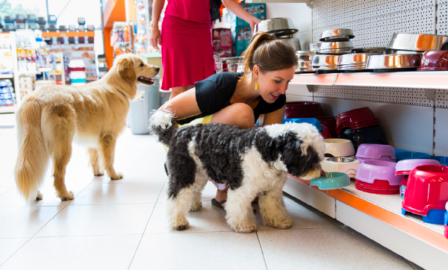Going DTC in the Pet Food Industry
The rising population of pets joining families coupled with the rising prominence of premium pet food has caused the pet food industry to skyrocket in recent years. What’s more is that the convenience of online shopping has created the perfect recipe for direct-to-consumer (DTC) pet food brands to thrive.
Only a few clicks away and often automatically renewable, online pet food shopping is quickly rising in popularity. Consumers have several options when shopping for pet food, including personalized food formulas, customized subscriptions, and guarantee for high-quality ingredients rather than traditional kibble. DTC pet food brands have created a foothold in the market by positioning themselves as a personalized and holistic option fit for any unique set of pet needs. Considering these factors, we expect to see the DTC pet food market grow at a CAGR of 25.2% and be worth $8.16 billion by 2028. So, how should the pet food industry take advantage of the growing market?
Below are key influences in market growth and factors to consider when catering to consumer and pet needs.
Omnichannel Shopping
As the pandemic eases and consumers return to pre-pandemic normalcy, the subscription-based DTC lifestyle has stuck around – especially for pet food. Over the past two years, many new DTC brands emerged selling fresh and customized food to serve consumers looking for the best options for their pets. For example, Maev launched in 2020 as the first human-grade raw food brand selling subscription-based products. Since launch, the brand has expanded to sell bundles for various dog profiles including young, elderly, small, and large. The fresh and raw food categories are steadily growing in popularity, paving the way for manufacturers to offer new lines of toppers, treats, and full meal plans. These DTC pet food brands have a unique advantage for foods with shorter shelf-life by delivering direct to homes in comparison to holding shelf space in stores.
Pet retailers have to be more mindful of omnichannel pet shoppers now more than ever, as they are feeling increased competition from e-tailers like Chewy and DTC brands. Consumers will search and compare brands across factors such as food quality, personalization for their pet’s needs, price, and value. We see pet retailers recognizing the appeal of DTC brands by featuring them in stores. Take PetSmart, who announced an in-store partnership to sell Nom Nom, a DTC frozen pet food brand, in April 2022. This adds to the list of DTC brands including Freshpet and Instinct which PetSmart already sells. PetSmart, among other retailers, recognizes the growth opportunity for frozen food. Since pet owners thrive in omnichannel pet food purchasing, we expect to see continued partnerships among DTC brands and retailers alike to expand their reach and learn more about consumer habits.
Pet Humanization
Consumers are increasingly shopping for premium food products and ingredients. Amongst many reasons including a rise in cooking from home, desire for immunity support, and health consciousness, consumers are willing to spend more money for minimally processed, all-natural food. This desire for high quality food translates into pet food, too. However, retail stores are limited in what they can carry, and consumers who want customized food plans for their animals may not be able to find it as easily in stores as online.
This growing trend is important both for retailers and manufacturers who should adapt more customizable pet food options. While retailers are constrained by shelf space and a need to appeal to broad sectors of the market, it’s still possible to make a commitment to the most common customized choices such as to address obesity, immune health, and more natural ingredients.
The Impact of Emerging DTC Brands
Consumers have begun to shift away from name brand options in favor of those that are smaller but offer healthy, organic, or other special benefits. On average, half a million new businesses were created each year during the pandemic, often fueling niche market segmentations. The pet food industry is certainly no exception and is filled with fresh faces which larger brands must now contend with.
Companies like The Farmer’s Dog and Hungry Bark are great examples of smaller companies flexing their customizable and personalized DTC appeal. Both offer subscription-based meal packs that are custom made based on a pet’s lifestyle, weight, preference, allergies, and more. With personalization comes a higher price tag, which consumers are willing to pay if it means providing better care and health for their pet.
Incumbent brands like Purina have capitalized on pet food personalization and online ordering. Purina sells their Pro Plan product line through their own website, which offers specialized nutrition to address many of the same issues such as allergies, probiotics, and better immune responses. There are also manufacturers like 9Lives that rely solely on Chewy or other online retailers for their DTC needs.
Pet food manufacturers can select to own the DTC experience at the expense of technology investment, but with greater benefits in building consumer engagement and capturing first-party data. Manufacturers who seek to broaden their reach without committing to the infrastructure of their own DTC channel could continue forming partnerships with e-tailers and retailers like Chewy, PetSmart, and Target. Both options serve as examples of the omnichannel selling prevalent in the pet food industry.
Looking Forward
Omnichannel pet food shopping is here to stay. We expect to see the lines blur across DTC-only brands and traditional manufacturers among online and offline channels. With that said, the American Pet Products Association (APPA) noted in a survey that overall purchasing of pet products in stores has declined by 15% between 2022 and pre-pandemic. Pet food manufacturers should remain aware of the increased competition and shifting preferences of consumers as the DTC pet food industry grows in the years to come.
Subscribe to Clarkston's Insights
Contributions from Jake Park-Walters




